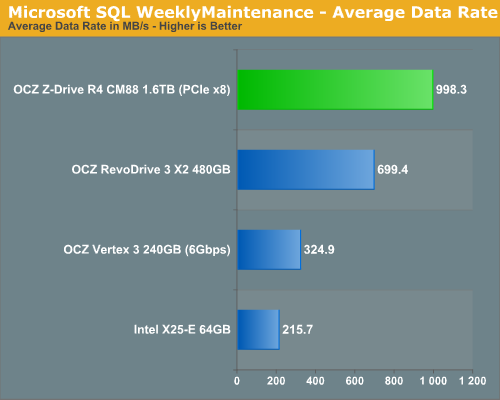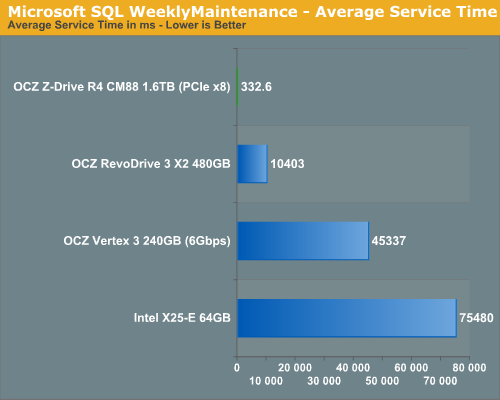OCZ Z-Drive R4 CM88 (1.6TB PCIe SSD) Review
by Anand Lal Shimpi on September 27, 2011 2:02 PM EST- Posted in
- Storage
- SSDs
- OCZ
- Z-Drive R4
- PCIe SSD
Enterprise Storage Bench - Microsoft SQL WeeklyMaintenance
Our final enterprise storage bench test once again comes from our own internal databases. We're looking at the stats DB again however this time we're running a trace of our Weekly Maintenance procedure. This procedure runs a consistency check on the 30GB database followed by a rebuild index on all tables to eliminate fragmentation. As its name implies, we run this procedure weekly against our stats DB.
The read:write ratio here remains around 3:1 but we're dealing with far more operations: approximately 1.8M reads and 1M writes. Average queue depth is up to 5.43.

We don't see perfect scaling going from 4 to 8 controllers but the performance gains are tangible: +42% over the RevoDrive 3 X2 and nearly 3x the performance of a single Vertex 3.


Average service time continues to be where the Z-Drive R4 really dominates. The use of 8 controllers in parallel appears to be able to significantly reduce average service times when queue depths skyrocket. The R4 CM88 is now over two orders of magnitude (136x) faster than a single Vertex 3—and 227x faster than the Intel X25-E. Again we see that the RevoDrive 3 X2 is much slower than it should be here, possibly pointing at a firmware bug or some other enhancement on the Z-Drive R4.










57 Comments
View All Comments
josephjpeters - Tuesday, September 27, 2011 - link
And why is that? Because of the supposed high failure rates? Can you supply any real information about this?OCZ has less then 1% failure rate. There may be more then 1% of customers who have "issues" but they aren't related to the drive. User error plays a pretty big role, but of course it MUST be OCZ's fault right?
Enterprise customers are professionals who know how to install serious hardware like this. And if they don't? OCZ will help install it for them on site. That's what enterprise companies do!
Troff - Tuesday, September 27, 2011 - link
I don't believe that 1% number for a second. First of all, I read some return stats from a store that listed the RETURN rate at just below 3%. Secondly, I know of 5 very different systems with Vertex 3 drives in them. All 5 have recurring lockups/BSODs. The people who built and run these systems write their own filesystems. They are extremely knowledgeable. If they can't make them run properly, they are not fit to run outside of a lab environment.That said, I suspect it's as much Sandforce that's the problem as it is OCZ.
josephjpeters - Wednesday, September 28, 2011 - link
I think it's an Intel problem. But NooOoOo... it can't be an Intel problem...geddarkstorm - Wednesday, September 28, 2011 - link
From all the data I've been seeing, it seems to be a SATA III issue, and an issue with motherboards not being reading for such high volumes of data flow. Mechanical drives can get no where near SSD speeds, and I don't think manufacturers were really expecting how fast they'd go on SATA III (almost pegging it out at times, and it's brand new!).josephjpeters - Wednesday, September 28, 2011 - link
Exactly. It's not an OCZ issue, it's the motherboard. When will someone step in and take the blame?Beenthere - Tuesday, September 27, 2011 - link
SSDs appear to be an on-the-job learning program for SSD manufacturers with all the issues that currently exist.I do not however believe they are selling SSDs at low margins.
Enterprise won't use SSDs yet for the same reason informed consumers won't use them - they have serious reliability and compatibility issues. Unless you can afford lost data and a hosed PC, SSDs are not even an option at this point in time. Maybe in a couple more years they will sort out the problems that should have resolved long agao?
dave1231 - Tuesday, September 27, 2011 - link
I wonder really how much a consumer SSD costs to produce. Saying that slim margins will force companies out of business if there's a big markup on a 128GB is not true. These same drives were $100s of dollars last year and probably still aren't good value today. Unless you're saying consumers are waiting for the .50c/GB drive.josephjpeters - Tuesday, September 27, 2011 - link
It's roughly 20% margins and the price of an SSD is directly related to the cost of Flash. Owning the controller IP is key in maintaining solid margins.Enterprise drives will drive flash demand which will lead to economies of scale that result in cheaper Flash prices and consequently cheaper consumer SSD's.
ChristophWeber - Tuesday, September 27, 2011 - link
Anand wrote: "I've often heard that in the enterprise world SSDs just aren't used unless the data is on a live mechanical disk backup somewhere. Players in the enterprise space just don't seem to have the confidence in SSDs yet."I use an SSD in an enterprise environment, a first gen Sandforce model from OWC. I do trust it with my main workload - database and web server in this case, but of course it is still backed up to mirrored hard drives nightly, just in case.
I'd have no qualms deploying a Z-Drive R4 in one of our HPC clusters, but it'd be an RM88 model with capacitors, and I'd still run the nightly rsync to a large RAID unit. Now if someone would finally signal they want to spend another $100k on a cluster, and I'll spec a nice SSD solution for primary storage.
nytopcat98367 - Tuesday, September 27, 2011 - link
is it bootable? can it b used 4 a desktop too?